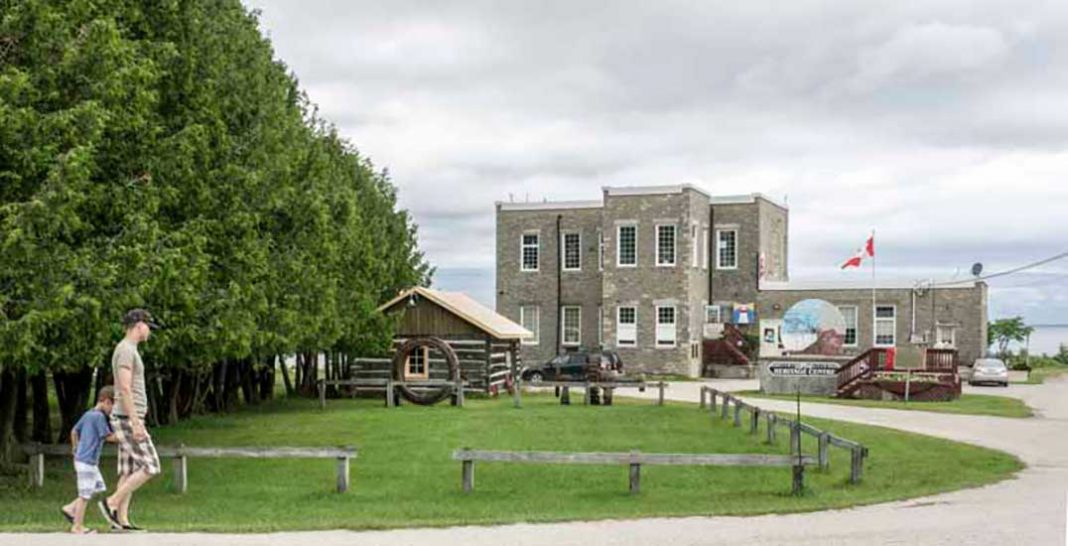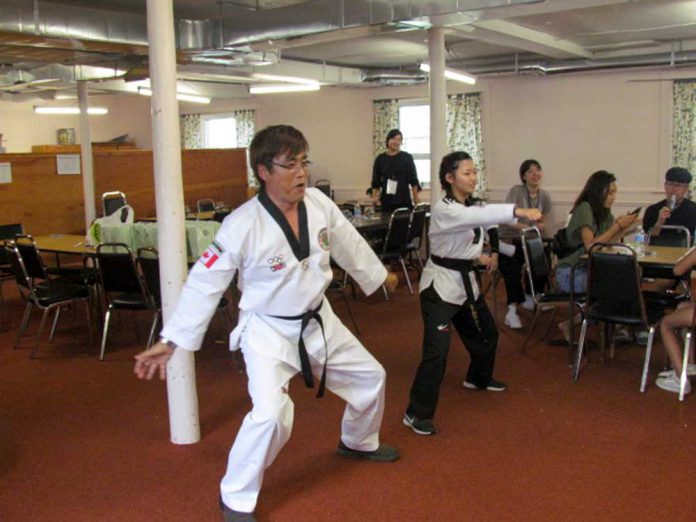KAGAWONG—This year’s History Day in Kagawong drew the largest crowd the annual program has ever seen in the past. In fact, this year’s afternoon presentation was so popular several people couldn’t find a seat and either stood in the crowd or came back for the evening show.
“We had between 120-130 people on hand for the afternoon presentation, and about 100 for the evening presentation,” said Miranda MacKay, a summer student at the Old Mill Heritage Museum this summer and master of ceremonies for the first half of the program.
The presentation came in two parts, the first half being about the history of Billings and the tragic tale of the Henry brothers, the founders of Kagawong, and the second focusing on the Danny Dodge tragedy.
Marcel Beneteau explained the first settler in Kagawong was Luc Chatreau, a French Canadian settler trapper and prospector, after the McDougall Treaty.
“With the recommendation of Luc Chatreau, Robert Henry applied for lumber rights on Manitoulin Island,” said Ms. MacKay. “He was granted the rights to mill 700 acres on the northeast side of Lake Kagawong on August 22, 1873. These rights were given under narrow conditions. Along with the lumber mill, a grist mill (or flour mill) store, and church must be built, and 12 families must be brought to Manitoulin Island to settle.”
By 1874, Robert Henry had built a sawmill, store and boarding house; the grist mill would be built the next year. Clearing farmland was made much less daunting by a fire that had swept through Billings in the fall of 1873. It was still smoldering when settlers came in the spring of 1874. These settling families, and others that came soon included names familiar to us, as their descendants still live in Billings: “Hunt, McGinnis, Thompson, Tustian, Foster, Bowser, Bailie, Farquhar, Graham and Gordon, to name a few.”
The mill Robert Henry built in 1874 was located at the top of Bridal Veil Falls, and power from the river was used to run the mill and to float logs down from the lake.
“When Robert had completed the initial requirements, he was granted more land,” said Ms. MacKay. “By late 1877, he owned more than 4,000 acres in Billings and Allan township. Lumber and land was donated for a church to be built in 1881. It was intended to be a Methodist church, but was shared by all Protestant denominations because it was the only church in the area.”
When Robert Henry controlled the Kagawong mill, his older brother William stayed at the family mill in Mulmur, in southern Ontario, with his wife Louisa and their five young children. The brothers often travelled between the two mills, by ferry from Owen Sound to Manitowaning, which was the shortest route to the Island.
“Unfortunately this proved tragic for the brothers,” said Ms. MacKay. “On May 17, 1882, Robert was travelling to the Island on the steamship Manitoulin when a fire broke out in the engine room, caused by an overturned coal lamp. Robert Henry jumped overboard to help the other passengers. Despite being a strong logger and very good swimmer, Robert had a heart attack in the icy water and died.”
Ms. MacKay explained that after the death of his brother, William took over operations on Manitoulin until tragedy struck once more. “Making the same trip to the Island from Owen Sound on the S.S. Asia, a storm came up, damaging and capsizing the poorly loaded ship. William and all but two passengers drowned. His body washed ashore weeks later in Parry Sound. It is said that the Asia was not built for travelling on the Great Lakes and she was not equipped with enough lifeboats for the passengers on board.”
After William’s death, his wife Louisa sold the lumber mill to James Carter, who owned mills on Tobacco and Wolsey Lakes. She never returned to Manitoulin Island. Their son, George S. Henry, would go on to become Premier of Ontario from 1930 to 1934.
“At this time, I would like to introduce you to the great, great granddaughter of William Henry: Mrs. Catherine Henry MacRae, who will read a letter from her great grandfather, Premier George S. Henry to Austin Hunt Jr. dated March 1956.”
Ms. MacRae told the gathering, “I remember the paintings of both of them (Henry Brothers) growing up, and thankfully the paintings are in Kagawong (in the Billings municipal office) where they should be.”
In his letter to Austin Hunt, dated March 13, 1956 George S. Henry wrote, “in reply to your favour of the 23rd Ult, would say I fear I can give you little of value as I was only a boy, 11 years old, when my uncle Robert and my father (William) were lost in two boat disasters, in the same year (1882) in Georgian Bay. However, I shall attempt to give of my recollections.
The Henrys, my father William and his brothers, were lumbermen in York and Dufferin Counties in lower Ontario. And sometime in the 1970s W&R Henry (William and Robert) went to Kagawong as their other limits were being cut out. What timber was acquired on Manitoulin was around Lake Kagawong, as they planned to use the falls at the outlet of this lake for power.
Our family, mother and five children were in the habit of summering on Mudge Bay. I remember we went picnicking on I think Goosberry Island and as a storm came up and we had to stay overnight and await the water becoming smoother, my mother was not along with us. So a fire was lighted to assure those on shore that we were all right.
I well remember playing in a chute that was constructed down which water could carry the lumber from the sawmill, down to the dock from which it could be shipped. We had taken many families from our older mill up to Kagawong. The Thompsons, Hunts, McGuinness etc. When we ceased operations and sold our limits we retained Bass Island as a keepsake.
My uncle Robert on his way from Owen Sound was on the S. S. Manitoulin May 18, 1882 when she took fire in Manitowaning Bay,” read Ms. MacRae.” She was sailing south, nearing the dock, when the fire broke out in the engine room, caused by an upturned lamp. I learned from the Captain (B1. Pete Campbell) some years later that there was a strong wind blowing from the East and he found it necessary to continue south, to pass a reef, and then turn into the wind and beach the vessel on the east shore of the bay, keeping the bow of the boat into the wind.”
“My uncle was a strong swimmer and jumped overboard, and (but?) before making shore perished in the water, ice floating around,” read Ms. MacRae. She continued, “my father was making the same trip on September 14, 1882, just under four months later. The boat was the S.S. Asia, which had been brought into service replacing the burned Manitoulin.”
“With these two deaths there was no Henry to carry on as I, the eldest of the family, was a boy at school. So our operations were closed down,” wrote George Henry.
The program then included several living links providing stories of descendants of what it was like to be a pioneer on Manitoulin Island. A copy of a diary of a Mr. Lloyd was presented by Don Lloyd, the Social Life in Billings, from a diary of Helen Tracy was read by her daughter Candy Tracy, a view of pioneer life was ready by Peter Gordon and the Fosters diary was read by Ethel Newburn.
Throughout the program musical entertainment was provided by Lyle and Darrel Dewar, performing songs that were on the hit charts during the days of the Henry brothers, and a song was presented by Mr. Beneteau.
“One of the hit songs was the ‘Log Drivers Waltz’ said Darrel Dewar, and they were accompanied by Mary Buie and others in attendance to sing songs like the Turkey in the Straw, How Great Thou Art and others during the presentation.
A square dancing song was sung by the Dewars, prior to the intermission.
And, during the intermission, freshly baked muffins and goodies from the pioneer times were on hand to sample.
See next week’s edition for a further story on the Daniel Dodge tragedy.





